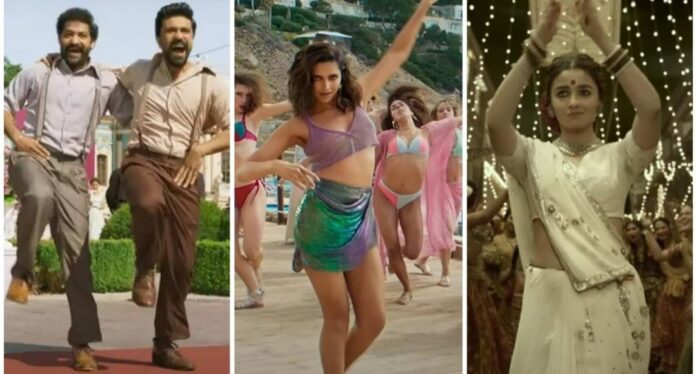Over the years, Hindi cinema has gifted us with timeless dance moves, yet recently, the hook step has risen as a popular new tactic for movie promotion.
Choreographer Prem Rakshith experimented with 110 dance moves before finalizing the hook step of the Oscar-winning song “Natu Natu” in 2022. SS Rajamouli, the director of RRR, desired steps that were visually appealing when performed by two individuals but not overly complex for others to replicate.
The outcome of that straightforward yet demanding instruction was evident for everyone to witness and, naturally, to dance along with.
Lately, the hook steps of certain songs like the catchy beat of “Jamal Kudu (Animal),” the graceful movements of the “Teri Baaton Mein Aisa Uljha Jiya” title track, the energetic “Kaavaalaa (Jailer),” and the dynamic “Jhoome Jo Pathaan (Pathaan)” have gained significant popularity on social media platforms.
Among the other notable hook steps in recent years are “Saami Saami” from “Pushpa: The Rise,” “Dholida” from “Gangubai Kathiawadi,” and “Thumkeshwari” from “Bhediya,” all of which captivated audiences well before the films premiered in theaters.
Choreographers share with BT the process behind crafting these memorable hook steps and its role in attracting attention to the film.
“Simplicity is Key for the Hook Step”
Choreographer Bosco Martis, the mastermind behind the choreography of “Jhoome Jo Pathaan,” emphasizes the significance of hook steps, explaining that they evoke a specific energy that resonates with the audience, often leading to viral sensations. Martis stresses the importance of simplicity in hook steps, advising creators to prioritize ease of execution during the creative process.
“The Hook Step Embeds Itself in the Legacy of Bollywood Cinema”
Choreographer Shiamak Davar emphasizes the significance of the hook step in shaping the audience’s memory of a song, citing the example of “Dhoom 2” where a straightforward step contributed to its widespread popularity. Davar highlights how the hook step becomes ingrained in the history of Hindi cinema, leaving a lasting impact on audiences.
“Accessible to All: Even Those Who Don’t Dance Can Join In”
Choreographer Vaibhavi Merchant, renowned for her work on dance sequences in songs such as “Kajra Re,” “Aaja Nachle,” “Dholi Taro,” and “Besharam Rang,” emphasizes the significance of the hook step, particularly in teasers and trailers.
The concept is to make the dance accessible even to those who don’t typically dance. I’ve strived to invent dance moves that defy convention, ensuring that each of my songs stands out with its unique choreography.
“Choreographers Need to Grasp an Actor’s Body Language”
Choreographer Caesar Gonsalves, who, alongside Bosco, received the National Award for “Senorita” in “Zindagi Na Milegi Dobara,” emphasizes the importance of comprehending and adapting to each actor’s unique body language. Gonsalves explains that actors like Hrithik and Tiger possess distinct movement styles, requiring choreographers to tailor their approach
accordingly.
Each actor possesses a unique style and body language. While certain dance steps may appear appealing on oneself or the dancers, they might not necessarily suit the actor. A memorable hook step often contributes significantly to a song’s success, with past examples like “Dus Bahane,” “Mauja Hi Mauja,” “Aunty Ji,” “Chandigarh Kare Aashiqui,” “Raanjhanaa,” “Kanta Laga,” and “Lift Karade” resonating both with the actor and the audience, thereby proving effective.
“Engaging with a Hook Step Allows Viewers to Feel Included in the Film”
Choreographer Melvin Louis, known for his work with celebrities like Tiger Shroff, Nora Fatehi, and Varun Dhavan, observes that the trend of hook steps has significantly expanded.
A hook step serves as a segment of a movie that engages the audience, making them feel integrated into the film’s experience. Previously, viewers would solely watch films as spectators, but nowadays, individuals are participating by dancing and sharing reels online, thus becoming part of the cinematic spectacle. This phenomenon fosters a sense of unity among people. Despite many not being proficient dancers, a hook step offers them an opportunity to believe, ‘Ah yes, perhaps I too can attempt this.’
Noteworthy Hook Steps from Bollywood
- Chikni Chameli from Agneepath (2012)
- Ek Pal Ka Jeena from Kaho Na… Pyar Hai (2000)
- Muqabla Muqabla from Hum Se Hai Muqabala (1994)
- Dola Re Dola from Devdas (2002)
- Hawa Hawai from Mr.India (1987)
- Chaiya Chaiya from Dil Se.. (1998)























































